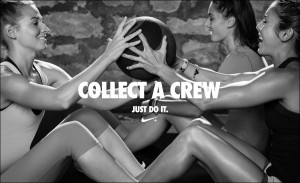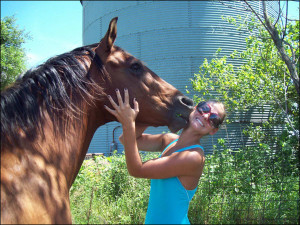Journalism Students Freelance for Publications Across the Country
Lauren Steele Is One Who Is Achieving Her Dreams of Working as a Fitness Writer
By Rebecca Dell
Columbia, Mo. (April 3, 2014) — Lauren Steele loves to run. This is a woman who can finish a half marathon in fewer than 7 minutes per mile.
But she also loves writing, and Steele just turned both areas of expertise into a relationship with Outside magazine, writing twice a week for a running column called “In Stride.” Freelancing by Missouri School of Journalism students is just one more proof the School’s methods work.

Steele, set to graduate in May, made her Outside debut with a November 2013 article on some of America’s Best Turkey Trots. The magazine writing student’s recent column topics include the correlation between long-distance running and times of national crisis; downsides of activity trackers like Nike’s FuelBand; and the need for movement, not just discrete workouts.
“I’ve been a runner my entire adult life,” Steele says, “and pairing that passion with writing was a natural fit. It was kind of a match made in heaven for me, really.”
Her Advanced Writing professor, Berkley Hudson, introduced her to Missouri master’s graduate and fellow runner Whitney Dreier, MA ’10, back when Dreier was the editor of Inside Columbia magazine. The two kept up their connection when Dreier moved on to New Mexico to work at Outside.
“The Mizzou Mafia is real,” Steele says. But that connection with Dreier was only the catalyst; Steele set herself up for the column contract by setting goals at age 18 and building a portfolio of clips during the past three years.
She freelanced throughout her college career, writing for outlets such as the Fleet Feet St. Louis newsletter and Snowshoe Magazine at the recommendation of Dreier. Her classes meshed with her freelancing experience: Fundamentals of Multimedia Journalism course with Shane Epping pushed her to explore different storytelling media. Hudson, also her work-study boss, mentored her in finding and appreciating stories.
From an Editor: Whitney Dreier, MA ’10, Shares Freelancing Advice
Be persistent.
“Every day, my email is full of pitches,” Dreier says, so students should follow up with editors after a week or two and know that editors will answer when they can.Be different.
Perhaps easier said than done, Dreier says. One example is a story she assigned on a brand-new trail through Eastern Europe. Look for something no one else has covered yet.If you have a mutual connection, say so.
Dreier says she gives priority to freelancers who bear recommendations from proven editors and writers.Do your research.
Dreier received a pitch for a story that was already on Outside’s homepage. She hit the delete immediately. A bit of research would have prevented this overlap.Be polite.
And, Dreier would add, gracious, and flexible and teachable – not just when pitching but also during the writing process. These qualities may be clichéd, but they make a difference to editors.
In Magazine Editing with Jennifer Rowe, Rowe taught verb conjugations and gave an example: Dived is the past tense of dive, not dove. A dove is a bird, a bar of soap or a brand of chocolate, Rowe said. Steele had just looked that up for an email to a source.
“That instance was a small personal victory for me that day,” she says. She attributes her preparedness for the industry to the faculty at the School of Journalism. “I hope they all appreciate that what they do is not in vain.”
Freelancing as Students
Other Missouri Journalism students are benefitting from the faculty and freelance opportunities, too.
Senior Allison Pohle, who is focusing on arts and culture writing, has been published in Inside Columbia, the St. Louis Post-Dispatch and The Toast daily blog. Magazine writing senior Ian Servantes writes daily aggregate posts for the Rides channel as well as develops lists and features at Complex, a multimedia platform geared toward young male consumers. Senior Kari Paul, who is studying international print and digital news, has been published in Bitch: Feminist Response to Pop Culture magazine.
Journalism students also have published work in the Kansas City Star, Missouri Life and the Pitch in Kansas City, among others. A travel-writing anthology, “A Woman’s World Again: True Stories of World Travel,” is accepting student work.
Students initiate opportunities in several ways, Rowe says. They network with former students. They make connections during the Magazine Club’s annual trip to New York City, which includes a happy hour with University of Missouri alumni. They take class lectures to heart and start shopping their work to different publications. Rowe encourages students to always ask for compensation, as well.
Steele visited Rowe’s office one night in February, new contract in hand. She wanted one more person to read it before she finalized it in the morning. Rowe noticed that the start date on the contract didn’t line up with the date Steele had agreed to begin the regular column. These moments – in faculty offices, in classes, and elsewhere – are typical of professor interactions with students. Faculty provide feedback on story ideas, pitches, writing and editing. They connect students with contacts in the industry.
Associate Professor Mary Kay Blakely says professor-student networking works both ways. She turns to the network of freelancing current students when she needs connections.
“When I need information, that’s what I do,” she says. “I go to them and say, ‘Hey, I need leads.'”
That professor-student network, of course, is how Steele first connected with Dreier, who earned her bachelor’s degree in history major from the University of Virginia. By the time Outside hired Dreier as an associate online editor, the two had built up a relationship where Steele could ask Dreier for feedback on pitches.

Steele is now feeding into that cycle, too. A classmate of hers dreams of working for Outside, and Steele helped connect him with a potential opportunity to do so.
The chance for students to produce work for outside publications is a unique part of the School of Journalism’s teaching techniques. Those additional clips, Rowe says, push students to the top of their peer group when applying for jobs.
“I think it’s the epitome of the Missouri hands-on method,” Hudson says.
And students don’t stop once they graduate: Blakely is now guiding an anthology of the works of 36 former Missouri Journalism students called “Here, There and Everywhere.”
From Farm to Outside, Steele Creates Path
Steele, the first of her family to go to college, knew before she arrived at MU that she would have to work hard to take advantage of the opportunities provided by her family, her scholarship from the Hagan Scholarship Foundation, and the School of Journalism.

She grew up on a farm in Kirksville, Mo., and started running in high school. Her track and cross-country coaches encouraged her to set goals for herself and blaze the path she wanted to take.
In college, that translated into a lifestyle of drive and dedication, both athletically and academically.
“I decided that I could be an athlete on my own terms, and I didn’t have to have a jersey on my back anymore to be an athlete,” Steele says.
So she ran half marathons, worked for Hudson, and took 20 or more credits every semester in order to graduate in three years. She edits the calendar at Vox Magazine. Steele holds modeling contracts with the Naturally Fit and Sports+Lifestyle Unlimited agencies, trading banter with the journalism-trained public relations staff at Nike photo shoots. She emails her editors from her phone as she goes from class to class. On her one day off, Steele meets with her editor over the phone, contacts sources and drafts columns.
“Sometimes I don’t feel like a student anymore,” she says. Indeed, she’s halfway into the post-undergraduate world, thankful for the opportunity and making the most of it as always.
“I never, ever thought that little Lauren on the farm in Kirksville, Mo., would be doing all these things,” she says.
Updated: July 23, 2020